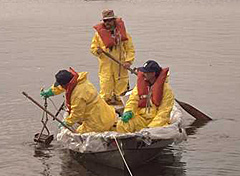
|
|
Contaminants can impact natural resources, public health and the economy. Most enter the environment from industrial and commercial facilities; oil and chemical spills; non-point sources such as roads, parking lots, and storm drains; and wastewater treatment plants and sewage systems. Many hazardous waste sites and industrial facilities have been contaminated for decades and continue to impact the environment.
NOAA acts as a trustee for coastal and marine resources under the authority of the Clean Water Act, the Comprehensive Environmental Response, Compensation and Liability Act of 1990, the National Marine Sanctuaries Act, the Coastal Zone Management Act, and the Oil Pollution Act of 1990. In addition, the National Oil and Hazardous Substances Pollution Contingency Plan (NCP) identifies the Department of Commerce as the primary federal trustee for protecting and restoring coastal resources affected by oil or hazardous materials. The NCP also describes NOAA’s role in providing scientific support during response activities and participating in domestic and international planning and response activities.
As part of NOAA’s responsibilities as a natural resource trustee, NOS response and restoration experts evaluate and address contaminants in the coastal environment. When contaminants threaten or harm aquatic species, make them unsafe to eat, or degrade their habitat, NOS experts work with partners to evaluate risks and injuries, develop strategies to reduce contaminant loads, and reduce the risk to species. They also monitor the effectiveness of cleanup actions, and design and implement projects to restore natural resources. In some cases, NOS scientists and economists conduct natural resource damage assessments (NRDA) to determine the nature and extent of damage to natural resources and the level of restoration necessary to restore the resources to a healthier state. Often, NOS works with the parties responsible for the contamination to ensure that the damaged coastal and marine resources are restored. NOS Cleanup and Restoration Tools
To build state and local capacities for evaluating coastal contamination and developing cleanup and restoration solutions, NOS has developed publicly accessible, site-specific geographic information system-based tools called Watershed Database and Mapping Projects. NOS also provides sediment screening tools and guidance to help coastal decisionmakers evaluate contaminated sediments. NOS scientists and experts conduct research and operate several assessment and monitoring programs to investigate the trends, biological effects, and toxicity of contamination in coastal waters. The marine ecotoxicology research program focuses on the coastal habitats of the Southeastern United States. The program aims to establish links between land use and the presence of chemical contaminants in the marine environment. NOS's Center for Coastal Monitoring and Assessment manages the National Status and Trends Program (NS&T), which conducts long-term monitoring, and documents the environmental quality of the nation’s coastal areas. The NS&T Mussel Watch Project annually collects mussels and oysters from more than 300 sites throughout the nation, analyzing these samples along with periodically collected sediment cores. A Bioeffects Team conducts studies to determine the incidence, severity, and breadth of contamination in living resources in coastal waters.
NOS addresses nonpoint source pollution through its Coastal Nonpoint Pollution Control Program. Nonpoint source pollution occurs when untreated sewage from boats, pets, and failing septic systems and stormwater runoff that picks up fertilizers, lawn chemicals, herbicides, salt from roadways, oil and gasoline drain into streams and rivers that empty into estuaries and coastal waters. States and territories with approved coastal zone management programs are developing and implementing coastal programs that are designed to reduce the amount of nonpoint source pollution in our waterways.
|
|
|||||||||||||||||||||||||||
|
|||||||||||||||||||||||||||||
|
Revised September 07, 2004 | Questions, Comments? Contact Us | Report Error On This Page | Disclaimer | User Survey |




